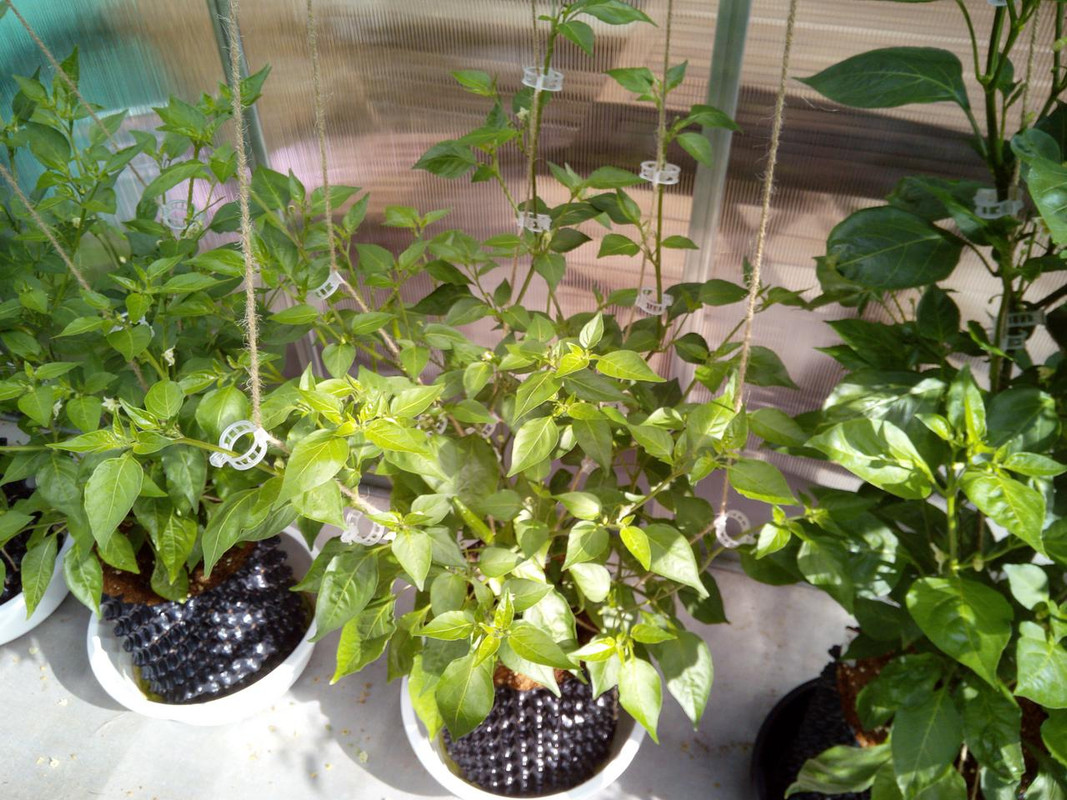-
Do you need help identifying a 🌶️?
Is your plant suffering from an unknown issue? 🤧
Then ask in Identification and Diagnosis. -
✅ Expert and friendly hot pepper grow advice.
✅ The latest information on hot pepper varieties.
✅ Reliable seed trading.
✅ Hot sauce recipes and food safety guidance.
✅ Hot sauce business tips for startups.
🌶️ And more!
It's all here, at The Hot Pepper! The Internet's original hot pepper community! Est. 2004.
You are using an out of date browser. It may not display this or other websites correctly.
You should upgrade or use an alternative browser.
You should upgrade or use an alternative browser.
soil-media Hesi coco 1-component fertilizer for coco growing
- Thread starter Chilidude
- Start date
solid7 said:I don't dispute that deep green isn't the whole truth, the same as huge leaves, huge stems, etc, etc.
That was a curiosity question. My own experience has shown me that if everything else is good, that deep green is icing on the cake.
You see that picture with the Aji cristal using the same dosage of Hesi coco fertilizer, why is it so deep green compared to the Aji lemon drop and the Hot paper lantern..
 These are one of those mysterious things i want to observe during the growing season, what makes it tick compared to the rest of the plants using the same fertilizer and does the Aji cristal deeper green color change to a lighter color when it have more flowers/pods hanging from the branches.
These are one of those mysterious things i want to observe during the growing season, what makes it tick compared to the rest of the plants using the same fertilizer and does the Aji cristal deeper green color change to a lighter color when it have more flowers/pods hanging from the branches.Sometimes, it's completely environmental. Is the lighting a bit different? Is the temperature just a bit different? Those variables are why some people in some parts of the world, grow better with the same media, nutes, etc, than others, with only EVs being different.
.
For some of the chinense, especially, they may love a bit cooler temps for growth, but that might not trigger pods the same way.
.
If you take 2 plants, and put them in 2 different grow tents, and do everything, except change the temp by just a few degrees, what will you see? (that's a function of the specific plant, of course)
.
This is all just speculation for your case, but it's proven true for the general case.
.
For some of the chinense, especially, they may love a bit cooler temps for growth, but that might not trigger pods the same way.
.
If you take 2 plants, and put them in 2 different grow tents, and do everything, except change the temp by just a few degrees, what will you see? (that's a function of the specific plant, of course)
.
This is all just speculation for your case, but it's proven true for the general case.
lek said:did you use unbuffered coco or buffered coco?
fertilizer with NPK 3-4-5 for coco medium seem weird to me.
coco has a lot K. it will release a lot of K, Na over time. Why NPK 3-4-5?
It is unbuffered coco and better ask directly from Hesi, why your coco fertilizer have NPK of 3-4-5...

Chilidude said:
It is unbuffered coco and better ask directly from Hesi, why your coco fertilizer have NPK of 3-4-5...
LOL... i think it's not ideal for growing pepper plant.
lek said:
LOL... i think it's not ideal for growing pepper plant.
LOL, it is made for growing that green stuff and who knows if the stuff is also good for growing chilis or not until it is tested, but for now it sure looks pretty promising to me.
Chilli focus fertilizer for example have the npk value of 3.0-1.0-4.4, the only major difference is that the Hesi coco have slighly more phosphorus that have a major role in root, flower and fruit development.
Chilidude said:
Hesi coco have slighly more phosphorus that have a major role in root, flower and fruit development.
P does have a major role in those things, but more of it doesn't have more of an impact. You either have enough, or you don't. More doesn't equal more. It's a logical (and scientific) fallacy.
Chilidude said:LOL, it is made for growing that green stuff and who knows if the stuff is also good for growing chilis or not until it is tested, but for now it sure looks pretty promising to me.
Also, "green stuff" grows exactly like all other plants. The marketing department makes us think that it's special, but good growers know otherwise.
hmmm... i dont think so. NPK 3-4-5(+coco medium) vs NPK 3-1-4.4 is a big difference. Pepper needs K > N > P.Chilidude said:Chilli focus fertilizer for example have the npk value of 3.0-1.0-4.4, the only major difference is that the Hesi coco have slighly more phosphorus that have a major role in root, flower and fruit development.
lek said:hmmm... i dont think so. NPK 3-4-5(+coco medium) vs NPK 3-1-4.4 is a big difference. Pepper needs K > N > P.
Sorry, lek. You're not correct.
.
K < P < N
.
The theoretical optimum uptake ratio for plants - according to plant scientists, not me - is 3-1-2.
.
This whole issue is mucked up and confused because people apply soil agriculture principles to all other types. Soil amendments are often added in a largely unavailable state, and become available over time, during the growing season. And it's also confused because many crops draw down Nitrogen during the grow cycle, so as not to waste, or add unnecessary nitrates. And it's unnecessary in those cases, because the entire plant is harvested - thus negating the need to keep it green.
.
And of course, your plants will never take up more of a macro, just because you offer it. It only takes what it absolutely needs, at any given time.
Chilidude said:It really doest matter to me what NPK value this particular fertilizer have, only one thing matters to me is, if you are satisfied of the results using it for growing chilis.
No argument with that. But since you're testing, my point was, and is... See what happens when you compare with something else in a different NPK setup. You're shooting for a target EC, so make that work for you. Whatever you load up in one config, is either going to be efficient, or rob you, in the long run. (unless you just really love flushing out your media)
.
Sorry if this discussion has become laborious. My assumption was that you were doing this to really put the nutrient under the microscope, and try to become more scientific in your approach as a grower. There's a lot of fallacies out there, and new growers read the same stuff we do.
solid7 said:
No argument with that. But since you're testing, my point was, and is... See what happens when you compare with something else in a different NPK setup. You're shooting for a target EC, so make that work for you. Whatever you load up in one config, is either going to be efficient, or rob you, in the long run. (unless you just really love flushing out your media)
.
Sorry if this discussion has become laborious. My assumption was that you were doing this to really put the nutrient under the microscope, and try to become more scientific in your approach as a grower. There's a lot of fallacies out there, and new growers read the same stuff we do.
That is why i test this particular fertilizer against the ghe nutes, that have the npk value of 6-2-6 and i know the Ghe nutes absolutely delivers the results when it comes to pod production but in the same time are very expensive nutes to use for growing multiple plants.
If this testing proves in the end that the Hesi coco fertilizer might have far better prize/performance value compared to these Ghe nutes i have used for many years now is one very important fact i like to know, as i really dont want to buy 84 euros nutes no more, if around 20-30 euros fertilizer does close to the same job while being really easy to use.
For now the Hesi coco have really big shoes to fill if it wants to get anywhere close to the results i have had with those Ghe nutes, because they where that amazing to me.
solid7 said:
Sorry, lek. You're not correct.
.
K < P < N
.
The theoretical optimum uptake ratio for plants - according to plant scientists, not me - is 3-1-2.
sorry solid7, you're not correct.
this is pepper!!! it's a heavy fruiting plant.
P < N < K
with K < P < N, your result will be far from maximum yield.

lek said:
sorry solid7, you're not correct.
this is pepper!!! it's a heavy fruiting plant.
P < N < K
with K < P < N, your result will be far from maximum yield.
Whatever you say.
OP doesn't like this conversation anymore. Have a nice day.
Another update:


I finally had to take sideways picture of the Aji cristal:


The stem is almost as thick as my...um pencil. It is actually pretty scary how fast these plants have grown since the last update.
To all of you fancy people regarding optimal/ideal NPK values for chili growing:

The whole point is that you could have the most perfect fertilizer ever created but it alone cant create miracles, as it all comes down to how good you are as a grower in the end.


I finally had to take sideways picture of the Aji cristal:


The stem is almost as thick as my...um pencil. It is actually pretty scary how fast these plants have grown since the last update.
To all of you fancy people regarding optimal/ideal NPK values for chili growing:

The whole point is that you could have the most perfect fertilizer ever created but it alone cant create miracles, as it all comes down to how good you are as a grower in the end.
Chilidude said:The whole point is that you could have the most perfect fertilizer ever created but it alone cant create miracles, as it all comes down to how good you are as a grower in the end.

The_NorthEast_ChileMan said:
The whole point is that you could have the most perfect fertilizer ever created but it alone cant create miracles, as it all comes down to how good you are as a grower in the end.

Chilidude said:To all of you fancy people regarding optimal/ideal NPK values for chili growing:
The whole point is that you could have the most perfect fertilizer ever created but it alone cant create miracles, as it all comes down to how good you are as a grower in the end.
By the same token, sometimes we give ourselves too much credit.
.
More often than not, it has nothing to do with personal talent - and everything to do with conditions. All of the talk about NPK is just discussion. You definitely won't create miracles, but you can certainly create problems. In hydro, you don't necessarily have to be a good grower. You just need to present the right conditions, and follow the label instructions.
.
The NPK discussions are valuable to those who want to grow more, spend less. I'm sorry I don't have a clever meme to drive that point home.
